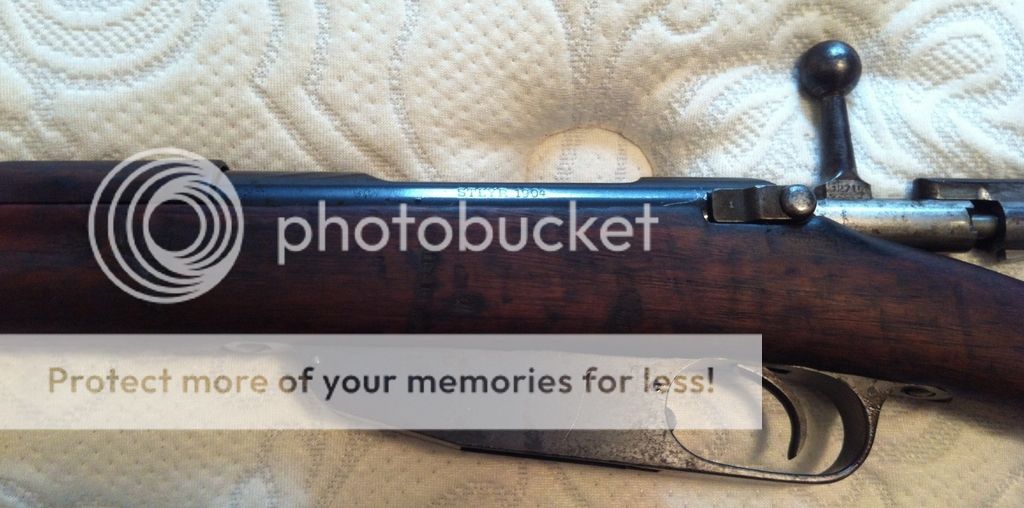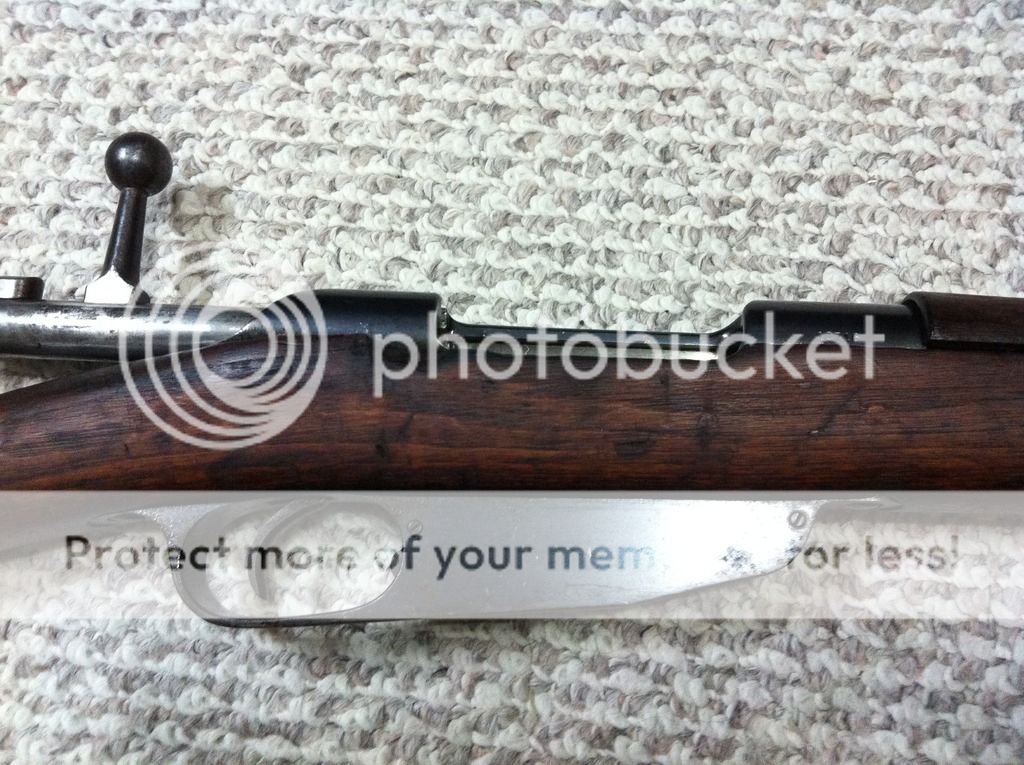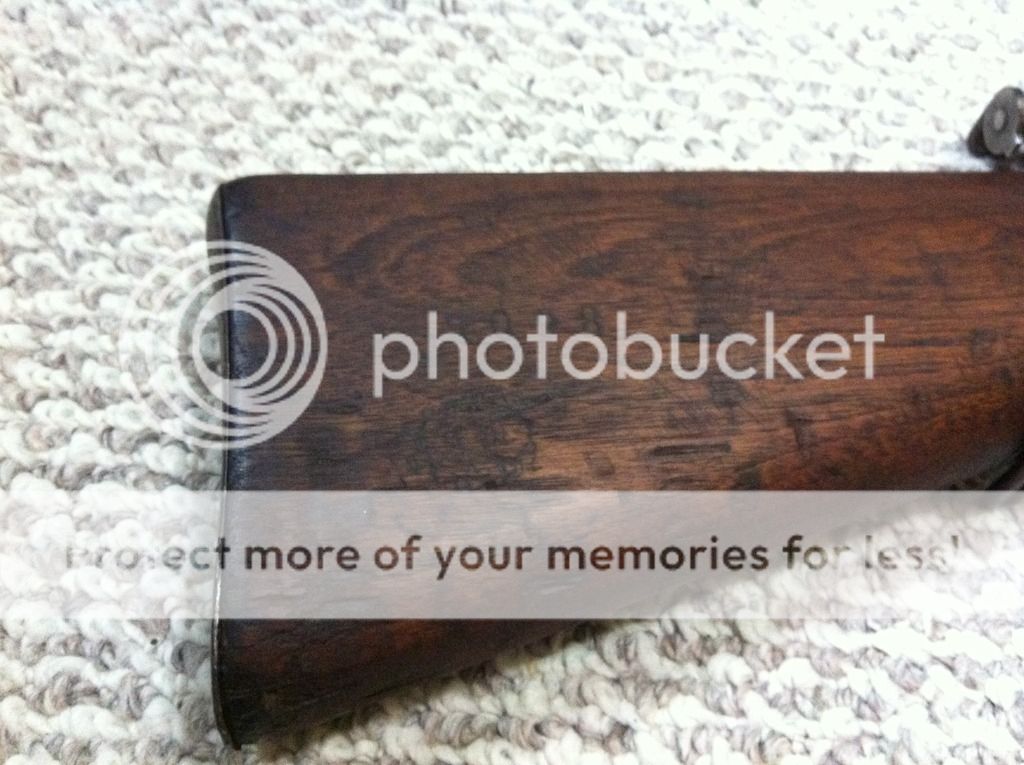Sorry for the low-res cell phone pictures but my camera is out of commission and I've been wanting to show this off for a week! I just received a Mannlicher M1904 Exportmodell from a board member - it's in pretty decent shape with nice bluing, although the muzzle end of the more is a little washed out, the cleaning rod is missing and the stock has been lightly sanded. It probably won't make a great shooter but I bought it as a collector anyways!
The M1904 was basically the result of Steyr having a ton of left over parts from their contract building the Romanian M1893 Mannlicher - they decided to assemble them into rifles more saleable for smaller international contracts. As such they were made in 8mm Mauser (the original .318 bullet load) using Gewehr 88 clips, which Steyr already sold quite successfully on the export market. Somewhat more than 20,000 were made, with a quantity going to China in the warlord era (exactly who bought them is unclear), the majority of production at about 12,000 being purchased by the Ulster Volunteer Force in Ireland, and the balance being sequestered into Austro-Hungarian Army service in 1914.
This, like most of the ones seen in North America, is one of the UVF's purchase. To understand the UVF you really have to understand Irish politics in the early 20th century. The ruling British Liberal government's policy was to enact Home Rule in Ireland, sort of along the lines of the current Scottish parliament. However, the protestant majority in Ulster, who had always dominated local politics, were dead set against becoming a protestant minority in a home-ruled Ireland. The UVF were an Ulster Protestant paramilitary group founded in 1912, dedicated to armed resistance to prevent Home Rule or, failing that, keep Ulster out of it. While officially against British government policy, they were privately supported by a number of Anglo-Irish army officers, some of whom resigned rather than follow orders to disarm them. Ironically in 1913 the nationalists formed their own paramilitary, the Irish Volunteers, to counter-balance the UVF, who would later become the IRA and win Irish independence. In 1914, before WW1 broke out, the UVF smuggled a large arms contingent into Larne, including the M1904s and many Gew 88s (the Gew 88s are supposed to be more numerous but period photos seem to show a lot more M1904s). The Irish Volunteers responded with their own gun running of 1200 Gewehr 71s into Howth, and civil war looked likely before WW1 intervened and Home Rule was put on hold for the duration.
The UVF, being dedicated to remaining British subjects, volunteered en-masse and formed the 36th Ulster Division, and put their Mannlichers into storage. They were largely wiped out at the Battle of the Somme and were never really a major force the Irish War of Independence to follow, but they remain an important if overlooked part of Irish history if only for instigating the Irish Volunteers and largely convincing the British government of the importance of partitioning Northern Ireland.



UVF serial number and the faint remains of the UVF Red Hand cartouche.


The whole Irish collection - the SMLE Mk.I*** is Irish Army issue from the 1922-23 civil war, the Royal Irish Constabulary carbine is obvious. The Gew 71 is not one of the actual Irish Volunteers examples but representative, as is the shotgun, being typical of the ones equipped most IRA local battalions (the captured British Enfields being reserved for the active-service Flying Columns).

The M1904 was basically the result of Steyr having a ton of left over parts from their contract building the Romanian M1893 Mannlicher - they decided to assemble them into rifles more saleable for smaller international contracts. As such they were made in 8mm Mauser (the original .318 bullet load) using Gewehr 88 clips, which Steyr already sold quite successfully on the export market. Somewhat more than 20,000 were made, with a quantity going to China in the warlord era (exactly who bought them is unclear), the majority of production at about 12,000 being purchased by the Ulster Volunteer Force in Ireland, and the balance being sequestered into Austro-Hungarian Army service in 1914.
This, like most of the ones seen in North America, is one of the UVF's purchase. To understand the UVF you really have to understand Irish politics in the early 20th century. The ruling British Liberal government's policy was to enact Home Rule in Ireland, sort of along the lines of the current Scottish parliament. However, the protestant majority in Ulster, who had always dominated local politics, were dead set against becoming a protestant minority in a home-ruled Ireland. The UVF were an Ulster Protestant paramilitary group founded in 1912, dedicated to armed resistance to prevent Home Rule or, failing that, keep Ulster out of it. While officially against British government policy, they were privately supported by a number of Anglo-Irish army officers, some of whom resigned rather than follow orders to disarm them. Ironically in 1913 the nationalists formed their own paramilitary, the Irish Volunteers, to counter-balance the UVF, who would later become the IRA and win Irish independence. In 1914, before WW1 broke out, the UVF smuggled a large arms contingent into Larne, including the M1904s and many Gew 88s (the Gew 88s are supposed to be more numerous but period photos seem to show a lot more M1904s). The Irish Volunteers responded with their own gun running of 1200 Gewehr 71s into Howth, and civil war looked likely before WW1 intervened and Home Rule was put on hold for the duration.
The UVF, being dedicated to remaining British subjects, volunteered en-masse and formed the 36th Ulster Division, and put their Mannlichers into storage. They were largely wiped out at the Battle of the Somme and were never really a major force the Irish War of Independence to follow, but they remain an important if overlooked part of Irish history if only for instigating the Irish Volunteers and largely convincing the British government of the importance of partitioning Northern Ireland.



UVF serial number and the faint remains of the UVF Red Hand cartouche.


The whole Irish collection - the SMLE Mk.I*** is Irish Army issue from the 1922-23 civil war, the Royal Irish Constabulary carbine is obvious. The Gew 71 is not one of the actual Irish Volunteers examples but representative, as is the shotgun, being typical of the ones equipped most IRA local battalions (the captured British Enfields being reserved for the active-service Flying Columns).

Last edited:















































































